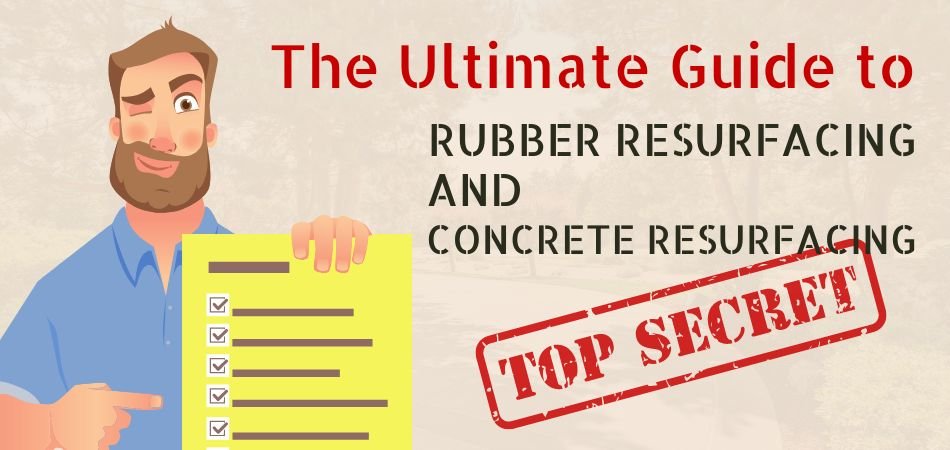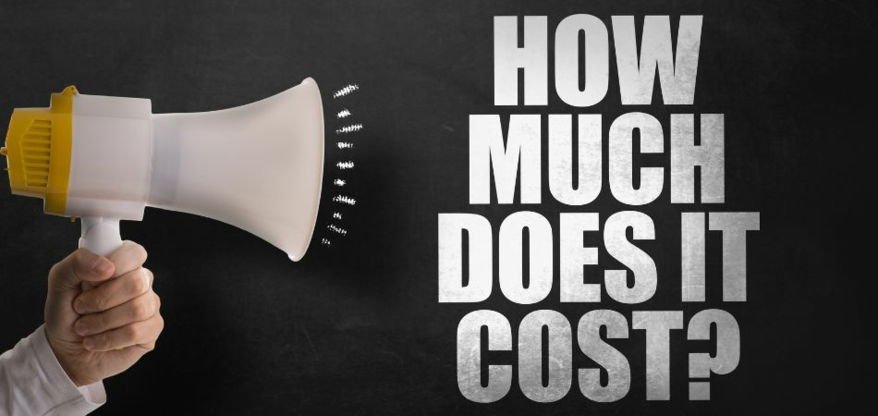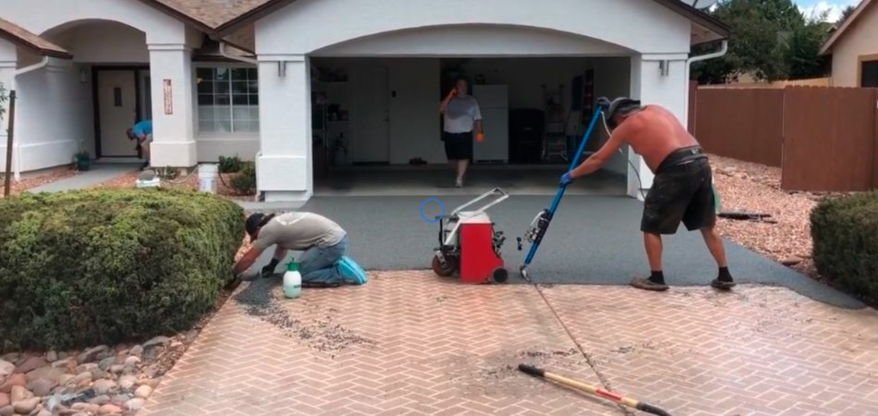


Rubber resurfacing and concrete resurfacing are two popular options for driveways, patios, and pool decks. Both materials have their own advantages and disadvantages, so it's important to weigh them carefully before making a decision.
Rubber resurfacing is made from recycled tires, which makes it a sustainable and environmentally friendly option. It's also very durable and long-lasting, and it can withstand a wide range of weather conditions. Rubber surfacing is also slip-resistant, making it a safe choice for areas where people are likely to walk barefoot, such as pool decks and playgrounds.
Concrete resurfacing is a more traditional option, and it's often the material of choice for driveways and patios. Concrete is strong and durable, and it can be easily customized to match any home décor. However, concrete is also more susceptible to cracking and damage from the elements. It also requires more maintenance than rubber surfacing, as it needs to be sealed and resurfaced on a regular basis.
Ultimately, the best choice for you will depend on your individual needs and preferences. Take a look at the differences below and decide which resurfacing option is going to be best for your next project.
Cost
The cost of rubber resurfacing and concrete resurfacing varies depending on a number of factors, including the size of the area to be resurfaced, the material being used, the finish and color of the concrete or rubber, and the labor costs in your area. In general, rubber resurfacing is more expensive than concrete resurfacing in the short term, but the easier maintenance and ability to withstand the elements reduces the long-term cost of rubber resurfacing.
Here is a breakdown of the average cost of rubber resurfacing and concrete resurfacing:

Rubber Resurfacing Cost
The cost of resurfacing with rubber varies depending on the factors mentioned above. You can expect to pay anywhere from $8 to $16 per square foot for rubber resurfacing.
Here are some additional factors that can affect the cost of rubber resurfacing:
- The thickness of the rubber: The thicker the rubber, the more expensive it will be. If your surface is extremely uneven or has large cracks, more material will need to be used to fill in those area.
- The type of rubber: There are a variety of different types of rubber available, each with its own unique properties. The type of rubber you choose will affect the cost of the project.
- The color of the rubber: Rubber can be colored and mixed in a variety of different ways. The color you choose will affect the overall cost of the project.
- The location of the project: The cost of labor will vary depending on the location of the project.
Concrete Resurfacing Cost
The cost of concrete resurfacing varies depending on the size of the area to be resurfaced, the type of concrete used, and the labor costs in your area. However, you can expect to pay anywhere from $5 to $12 per square foot for concrete resurfacing.
Here are some additional factors that can affect the cost of concrete resurfacing:
- The thickness of the concrete: The thicker the concrete, the more expensive it will be. Same as above, if you have areas where more material will need to be used to fill in gaps, your overall price will be higher.
- The type of concrete: There are a variety of different types of concrete available, each with its own unique properties. The type of concrete you choose will affect the cost of the project.
- The color of the concrete: Concrete can be colored in a variety of different colors. The color you choose will affect the cost of the project.
- The finish of the concrete: Concrete can be stamped in a variety of different ways. It can be made to look like stone and brick, or have a flat finish. Take this into consideration when you are looking at price.
- The location of the project: The cost of labor will vary depending on the location of the project.
Durability

The durability of a resurfaced area is very important in your decision making process. Durability can be affected by multiple things like proximity to pools and water features, geographical area, the surface and what it is used for, and the underlying surface.
Making the wrong choice will leave your new surface cracked and needing to be replaced before you know it.
Rubber Resurfacing Durability
Rubber is becoming the resurfacing option of choice on many different surface types because of its superior durability and ability to stand up to harsher conditions. Rubber has been installed over surfaces in Canada and has stood up to the extremely cold winters for decades. It has also been installed over driveways in the hot arid climate of Arizona and stands up to the extreme heat just fine.
Unlike Concrete, Rubber Stone can easily expand and contract during hot and cold seasons. This expansion and contraction is what causes cracks in concrete and when water gets in those cracks and freezes, it wreaks havoc! So if you are looking for a more durable option, Rubber will be the best choice.
Concrete Resurfacing Durability
Concrete has been used as a trusted hard surface option for thousands of years. The Romans used it as early as 600 BC. Concrete structures built hundreds of years ago still stand today. It's safe to say that concrete has stood the test of time. However, concrete has to be maintained. Many concrete structures that Rome built now lay in piles. Concrete highways built in the early 1900's are cracked and covered in weeds. You may even look out at your own driveway or patio and see it is in the same condition.
Concrete doesn't stand up well to extreme heat and cold. When it cracks and water turns to ice in the cracks, it pushes the concrete apart, making the problem worse. While concrete is a durable surfacing option, resurfacing with a thin layer of concrete is more prone to cracking, breaking and being destroyed. It just doesn't have the flexibility and durability of rubber.
Maintenance
Rubber surfaces and concrete surfaces both require some level of maintenance, but the level of maintenance required varies depending on the material. Rubber surfaces are generally easier to maintain than concrete surfaces.
Rubber Surface Maintenance
The main advantage of rubber surfaces is that they require very little maintenance. You can simply wash it off with a pressure washer with water and a mild detergent to keep the surface clean. If the surface becomes stained, you can use a commercial cleaner specifically designed for rubber surfaces. You seldom have to worry about cracks or chips in the surface. Every 5 years or so, the rubber surface will need to be rerolled with the epoxy sealant binder. This adds a layer of protection for the next 5 years.
Concrete Surface Maintenance
The main disadvantage of concrete surfaces is that they require more maintenance than rubber surfaces. Concrete surfaces need to be sealed regularly to protect them from the elements. This can be done with a clear sealant or a pigmented sealant. The sealant will need to be reapplied every 2-3 years, depending on the climate.
Concrete surfaces also need to be resurfaced on a regular basis. This is usually done every 10-15 years, depending on the traffic level and the climate. The resurfacing process involves removing the old concrete and applying a new layer of concrete.
You can easily clean a concrete surface with the same technique as a rubber surface but repairs, sealing and resurfacing are left to the experts. This will add up.
The Process
The main difference between applying rubber and concrete is the time it takes to cure fully and the necessary tools. Rubber is easy to lay down, it is poured in place, and the curing time is half that of concrete. Concrete, on the other hand, requires a concrete truck, a large team, and often results in concrete on things you didn't want covered. The curing time is longer for concrete.
Rubber Resurfacing Process
The rubber resurfacing process typically involves the following steps:
- Preparation: The surface to be resurfaced must be clean, dry, and free of debris. Existing cracks and imperfection in the existing surface are covered by the rubber with ease.
- Application: The rubber is applied by pouring the mixture onto the surface and then using hand trowels or a specialized machine to spread the mixture evenly across the surface. Following the rubber, the epoxy sealant is applied in 1-2 coats to give it maximum resistance to the elements
- Curing: The rubber must cure for a period of time before it can be used. The curing time varies on the climate and the surface but generally speaking, the surface is ready to use within 48 hours.

Concrete Resurfacing Process
The concrete resurfacing process typically involves the following steps:
- Preparation: The existing concrete surface must be cleaned, repaired, and prepared for the new layer of concrete. This may involves removing any loose or damaged concrete, filling any cracks or holes, and abrading the surface to create a rough texture.
- Application: The new layer of concrete is poured and evenly applied to the prepared surface using a trowel or screed. The concrete is typically applied in a thin layer, and it must be allowed to cure before it can be used.
- Curing: The new layer of concrete must cure for at least 72 hours before it can be used. The curing time will vary depending on the type of concrete used and the weather conditions.

In conclusion, the benefit to concrete is the immediate cost. If you want a resurfacing option that is going to stand the test of time and cost much less in the long run, choose rubber resurfacing. Feel free to contact us for a quote today so we can show you just how you can benefit from Rubber Stone.
